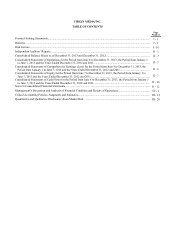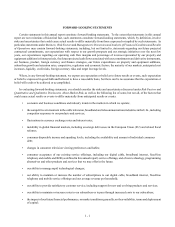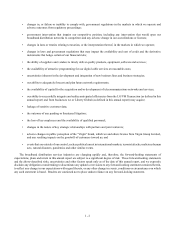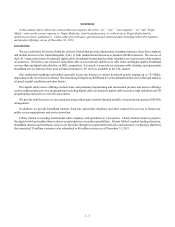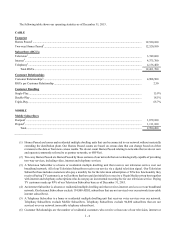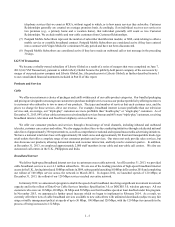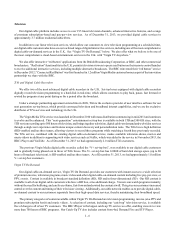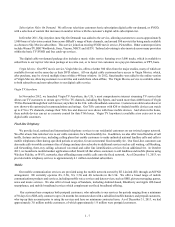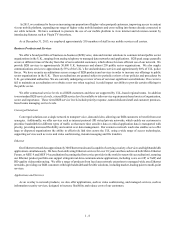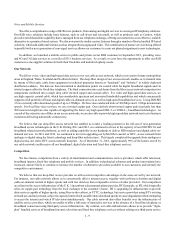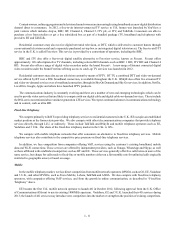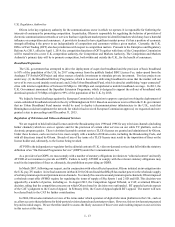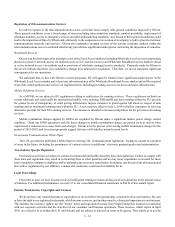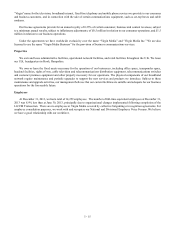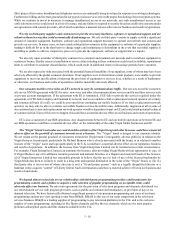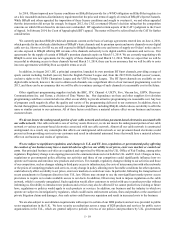Virgin Media 2013 Annual Report Download - page 11
Download and view the complete annual report
Please find page 11 of the 2013 Virgin Media annual report below. You can navigate through the pages in the report by either clicking on the pages listed below, or by using the keyword search tool below to find specific information within the annual report.I - 9
Voice and Mobile Services
We offer a comprehensive range of B2B voice products, from analog and digital services to converged IP telephony solutions.
Our B2B voice solutions include basic features, such as call divert and voicemail, as well as products such as Centrex, which
provides switchboard-like capability that is managed from our telephone exchange, offering our customers a cost-effective, scalable
alternative to a premises-based system. We also now provide similar centrex features through a number of hosted unified IP-based
solutions, which add additional features such as integrated messaging and video. This combination of mature services being offered
in parallel with a next generation of converged services allows our customers to carry out phased migrations to new technologies.
In addition, we launched a mobile service to public and private sector B2B customers in September 2013, providing voice
and 4G and 3G data services as a reseller of EE’s business services. As a result, we now have the opportunity to offer our B2B
customers a one-supplier solution for both their fixed-line and mobile telephony needs.
Our Network
We deliver voice, video and high-speed data services over our cable access network, which covers parts of many metropolitan
areas in England, Wales, Scotland and Northern Ireland. The deep-fiber design of our access network enables us to transmit data
by means of fiber optic cable from equipment in technical properties known as “headends” and “hubsites” to widely deployed
distribution cabinets. The data are then transmitted to distribution points via coaxial cable for digital broadband signals and via
twisted copper cables for fixed-line telephony. The final connection into each home from the fiber access network comprises two
components combined into a single drop cable (twisted copper and coaxial cable). For video and high-speed data services, we
use high capacity coaxial cable, which has considerable spectrum and associated bandwidth capabilities and which concurrently
supports a full portfolio of linear and digital cable-on-demand services as well as high-speed broadband services. Using DOCSIS
3.0 we currently offer download speeds of up to 152Mbps. We have also conducted trials of 300 Mbps and 1.5 Gbps downstream
speeds. For fixed-line voice services, we use a twisted copper pair. Our relatively short twisted copper pairs (typically less than
500 meters in length) are also capable of supporting the latest very high speed DSL 2, or VDSL2+, broadband technologies. As
a result of the extensive use of fiber in our access networks, we are also able to provide high-speed data network services to business
customers delivering nationwide connectivity.
We believe that our deep-fiber access network has enabled us to take a leading position in the roll-out of next-generation
broadband access technologies in the U.K. During 2011 and 2012, we continued to invest in the capacity of our DOCSIS 3.0 and
broadband related network platforms, as well as adding capability in our headends to deliver HD broadcast and digital cable-on-
demand services. In 2011 and 2012, we continued to invest in upgrading our hybrid fiber coaxial, or HFC, access network from
analogue to digital using the latest technology and deep-fiber architectures. This largely completed the upgrade from analogue to
digital across our entire HFC access network footprint. As of December 31, 2013, approximately 99% of the homes served by
our cable network could receive all our broadband, digital television and fixed-line telephony services.
Competition
We face intense competition from a variety of entertainment and communications service providers, which offer television,
broadband internet, fixed-line telephony and mobile services. In addition, technological advances and product innovations have
increased, and are likely to continue to increase the number of alternative providers available to our customers and intensify the
competitive environment.
We believe that our deep-fiber access provides us with several competitive advantages in the areas served by our network.
For instance, our cable network allows us to concurrently deliver internet access, together with real-time television and digital
cable-on-demand content at higher speeds and with less data loss than comparable services of other providers. Our competitors
are reliant on the access infrastructure of the U.K.’s incumbent telecommunications provider, BT Group plc, or BT, which typically
relies on copper-pair technology from the local exchange to the customer’s home. BT is upgrading its infrastructure to provide
data services capable of higher speeds, using fiber-to-the-cabinet, or FTTC, technology, but service providers using BT’s existing
network are, and may remain, subject to capacity limits which can affect data download speeds or cause degradation when attempting
to access the internet and watch IP television simultaneously. Our cable network also offers benefits over the infrastructure of
satellite service providers, which are unable to offer a full array of interactive services in the absence of a fixed-line telephony or
broadband connection using third-party access infrastructure. By contrast, our cable infrastructure allows us to provide “triple-
play” bundled services of broadband internet, television and fixed-line telephony services without relying on a third-party service


